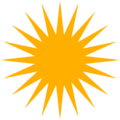Home › Forums › Visual Arts › TSK Ex. 26 – Transcendence of Pointings
Tagged: art, intimacy, pointing, process, transcendence
- This topic has 0 replies, 1 voice, and was last updated 10/06/2021 at 7:29 PM by David Filippone.
-
AuthorPosts
-
-
October 6, 2021 at 7:29 pm #781

[‘Winter Corn’, Watercolor painting by David Filippone]
I used to work with watercolors painting landscapes. The process from beginning to end is the implementation of countless pointings. There is an initial impression, which includes (a kind of whole), much more than will end up on paper. The initial impression was singled out of a continuous flow, but was ‘marked‘ because of some special lightening-fast connection; for instance [before the ‘I’ who labels and positions was even set up] there was an open knowing impression…. then a preliminary differentiating of sun-touched tips of objects highlighted, which triggered excitation and appreciation within, and thus ‘my’ desire to represent a likeness in an interpretive way with color on paper.
The process of pointing continues from the memory of the singled out impression to the choice of colors, how to obtain the right shades and hues by mixing certain ones, of what order to place them on the paper, to start with the lightest colors for background, and back and forth, slowly moving forward in the painting with darker colors. This moving from background to foreground, and from light broad suggestive but less defined strokes, to darker more detailed colors and elaborations, is what clarifies what is suggested far off, and what appears in the shorter distances, and gives nuance and definition to what perspective is meant to focus upon. These choices and pointings become ever narrower as the painting becomes clarified. In TSK terms, the read-outs from the initial impression in space and time, each shaped by the previous pointing forces the reality of the painting to move within the circle of established possibilities.
I make sense of the developing landscape painting through a continuous series of back and forth pointings, assimilating the current version of the painting to the memory of the original impression, attempting to extract coherence as the painting develops. Borrowing from a Rinpoche quote I added as if painting, “Shaped at every stage through a passing on and [adding color], an interweaving and feeding back, the [painting] as it has been received becomes the accepted truth of what actually [appeared].” The direct experience of the original impression gradually becomes subordinated to the emerging, specific landscape painting — a new ‘frozen‘ reality is shaped.
But there can be another level, where at some point the process becomes less about ‘me‘ doing and controlling the painting, and more about the process of painting. When this happens, in a sense, ‘the painting paints itself‘. Process seems to take over at a more fundamental level and doer dominance is relinquished, to return and fade as needed, back and forth. Pointings by a separated bystander-self are reduced to necessity or to a level that does not emphasize separation and distance, and objects touch and interact with themselves as they appear and develop in time and space.
But there is yet another level I sometimes get a sense of when I seem immersed in impressions along the way, prior to establishing ‘I am here‘, and prior to pointing and doing, where whatever arises does so with the allowing space that knows, like witnessing at the edge of time, where fundamental events burst into appearance without establishing anything, unconnected, and without cohesive meaning. When I emerge from that freedom there is a new energy and clarity. It’s like starting over fresh, clear, and ready.
- This topic was modified 2 years, 9 months ago by David Filippone.
-
-
AuthorPosts
- You must be logged in to reply to this topic.
